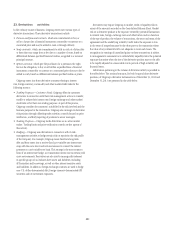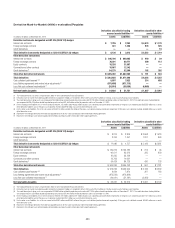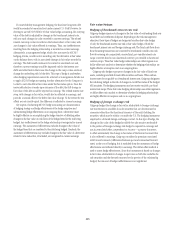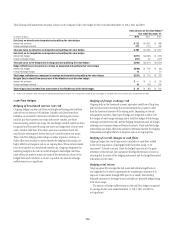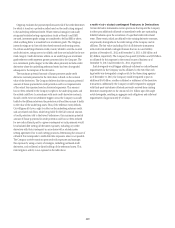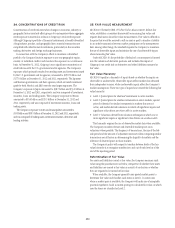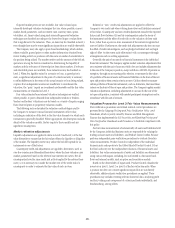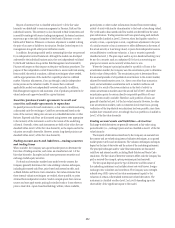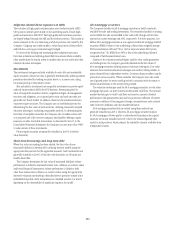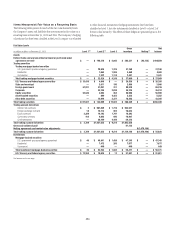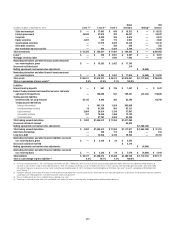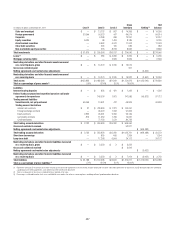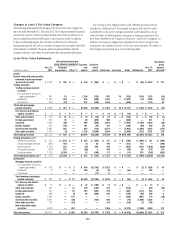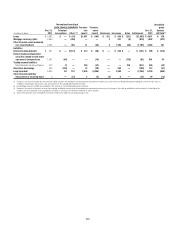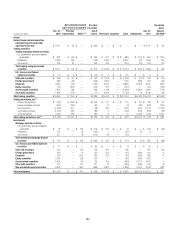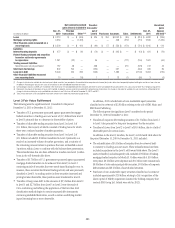Citibank 2012 Annual Report Download - page 273
Download and view the complete annual report
Please find page 273 of the 2012 Citibank annual report below. You can navigate through the pages in the report by either clicking on the pages listed below, or by using the keyword search tool below to find specific information within the annual report.251
If quoted market prices are not available, fair value is based upon
internally developed valuation techniques that use, where possible, current
market-based parameters, such as interest rates, currency rates, option
volatilities, etc. Items valued using such internally generated valuation
techniques are classified according to the lowest level input or value driver
thatissignificanttothevaluation.Thus,anitemmaybeclassifiedasLevel3
even though there may be some significant inputs that are readily observable.
The Company may also apply a price-based methodology, which utilizes,
where available, quoted prices or other market information obtained from
recent trading activity in positions with the same or similar characteristics to
the position being valued. The market activity and the amount of the bid-ask
spread are among the factors considered in determining the liquidity of
markets and the relevance of observed prices from those markets. If relevant
and observable prices are available, those valuations may be classified as
Level2.Whenlessliquidityexistsforasecurityorloan,aquotedpriceis
stale, a significant adjustment to the price of a similar security is necessary
to reflect differences in the terms of the actual security or loan being valued,
or prices from independent sources are insufficient to corroborate the
valuation, the “price” inputs are considered unobservable and the fair value
measurementsareclassifiedasLevel3.
Fair value estimates from internal valuation techniques are verified,
where possible, to prices obtained from independent vendors or brokers.
Vendorsandbrokers’valuationsmaybebasedonavarietyofinputsranging
from observed prices to proprietary valuation models.
The following section describes the valuation methodologies used by
the Company to measure various financial instruments at fair value,
including an indication of the level in the fair value hierarchy in which each
instrument is generally classified. Where appropriate, the description includes
details of the valuation models, the key inputs to those models and any
significant assumptions.
Market valuation adjustments
LiquidityadjustmentsareappliedtoitemsinLevel2andLevel3ofthefair
value hierarchy to ensure that the fair value reflects the liquidity or illiquidity
of the market. The liquidity reserve may utilize the bid-offer spread for an
instrument as one of the factors.
Counterparty credit-risk adjustments are applied to derivatives, such as
over-the-counter uncollateralized derivatives, where the base valuation uses
market parameters based on the relevant base interest rate curves. Not all
counterparties have the same credit risk as that implied by the relevant base
curve, so it is necessary to consider the market view of the credit risk of a
counterparty in order to estimate the fair value of such an item.
Bilateral or “own” credit-risk adjustments are applied to reflect the
Company’s own credit risk when valuing derivatives and liabilities measured
at fair value. Counterparty and own credit adjustments consider the expected
future cash flows between Citi and its counterparties under the terms of
the instrument and the effect of credit risk on the valuation of those cash
flows, rather than a point-in-time assessment of the current recognized net
asset or liability. Furthermore, the credit-risk adjustments take into account
the effect of credit-risk mitigants, such as pledged collateral and any legal
right of offset (to the extent such offset exists) with a counterparty through
arrangements such as netting agreements.
Generally, the unit of account for a financial instrument is the individual
financial instrument. The Company applies market valuation adjustments that
are consistent with the unit of account, which does not include adjustment due
to the size of the Company’s position, except as follows. ASC 820-10 permits an
exception, through an accounting policy election, to measure the fair value
of a portfolio of financial assets and financial liabilities on the basis of the net
open risk position when certain criteria are met. Citi has elected to measure
certain portfolios of financial instruments, such as derivatives, that meet those
criteria on the basis of the net open risk position. The Company applies market
valuation adjustments, including adjustments to account for the size of the
net open risk position, consistent with market participant assumptions and in
accordance with the unit of account.
Valuation Process for Level 3 Fair Value Measurements
Price verification procedures and related internal control procedures are
governed by the Citigroup Pricing and Price Verification Policy and
Standards, which is jointly owned by Finance and Risk Management.
Finance has implemented the ICG Securities and Banking Pricing and
Price Verification Standards and Procedures to facilitate compliance with
this policy.
For fair value measurements of substantially all assets and liabilities held
by the Company, individual business units are responsible for valuing the
trading account assets and liabilities, and Product Control within Finance
performs independent price verification procedures to evaluate those fair
value measurements. Product Control is independent of the individual
business units and reports into the Global Head of Product Control. It has
the final authority over the independent valuation of financial assets and
liabilities. Fair value measurements of assets and liabilities are determined
using various techniques, including, but not limited to, discounted cash
flows and internal models, such as option and correlation models.
Based on the observability of inputs used, Product Control classifies the
inventoryasLevel1,Level2orLevel3ofthefairvaluehierarchy.When
a position involves one or more significant inputs that are not directly
observable, additional price verification procedures are applied. These
procedures may include reviewing relevant historical data, analyzing profit
and loss, valuing each component of a structured trade individually, and
benchmarking, among others.


